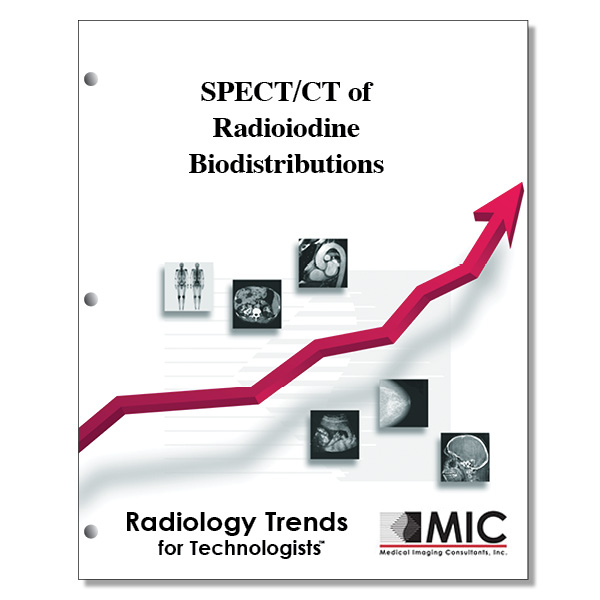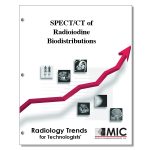

SPECT/CT of Radioiodine Biodistributions
The role of SPECT/CT in assessing physiologic uptake of radioiodine, normal variants, and metastatic disease mimics is presented.
Course ID: Q00378 Category: Radiology Trends for Technologists Modalities: CT, Nuclear Medicine3.0 |
Satisfaction Guarantee |
$34.00
- Targeted CE
- Outline
- Objectives
Targeted CE per ARRT’s Discipline, Category, and Subcategory classification:
[Note: Discipline-specific Targeted CE credits may be less than the total Category A credits approved for this course.]
Nuclear Medicine Technology: 2.50
Procedures: 2.50
Radionuclides and Radiopharmaceuticals: 0.50
Endocrine and Oncology Procedures: 1.50
Other Imaging Procedures: 0.50
Registered Radiologist Assistant: 1.00
Procedures: 1.00
Musculoskeletal and Endocrine Sections: 1.00
Radiation Therapy: 1.00
Patient Care: 0.50
Patient and Medical Record Management: 0.50
Procedures: 0.50
Treatment Sites and Tumors: 0.50
Outline
- Introduction
- Mechanisms of Radioiodine Uptake and Distribution
- Radioiodine SPECT/CT
- Imaging Protocol
- Head and Neck Region
- Thorax
- Abdomen and Pelvis
- Conclusion
Objectives
Upon completion of this course, students will:
- know the isotopes used for traditional planar thyroid scintigraphy
- recognize the estimated patient dose range per region of interest from the CT portion of a SPECT/CT study
- identify the body regions typically associated with benign distributions of radioiodine
- understand the function of the sodium-iodide symporter (NIS) glycoprotein
- understand the relationships between NIS function and iodine concentration in thyroid cells
- identify the similarity between human and animal NIS genetic coding
- identify the hormones involved with concentration of iodine in breast milk
- recognize unusual sites of metastases that can be evaluated by SPECT/CT
- understand the process of thyroglobulin production in the thyroid follicles
- identify the hormones produced by the thyroid gland
- recognize standard techniques for elucidating areas of questionable radioiodine uptake
- identify the body regions where iodine is actively transported by NIS
- identify “third-space” bodily fluids where radioiodine may concentrate
- recognize a typical dose of 131I when administered orally with endogenous TSH
- recognize a typical dose of 131I when administered orally with exogenous recombinant human TSH
- recognize the imaging delay for planar whole-body images and static images of the neck and thorax after 131I administration
- understand the processes responsible for radioiodine uptake in the teeth
- understand the process responsible for radioiodine uptake in the mediastinal blood pool
- understand the purpose of leaving remnant thyroid tissue during thyroidectomy
- identify the causes for neck uptake to be labeled as equivocal or indeterminate on planar images
- identify the hyoid bone as a site of intense focal uptake in the midline of the central neck
- recognize the components of the “tripod” configuration of radioiodine uptake in the neck
- identify the processes that may cause focal oral uptake that can mimic osseous metastases
- understand the conditions that may arise from prior radioiodine treatment of the salivary glands
- identify the imaging techniques used to identify uptake at the site of a tracheostomy tube
- recognize the patterns of esophageal retention of radioiodine secretions
- understand the imaging characteristics found after esophagectomy or gastric pull-through surgery
- recognize the uptake pattern associated with excretion of radioiodine into breast milk
- identify the patterns of uptake associated with thymic tissue in pediatric patients
- identify the expected sites of physiologic radioiodine uptake in the abdomen and pelvis
- understand the imaging interventions that can be used to characterize physiologic radioactivity in the bowel resulting from enteric excretions
- identify the process that may cause uptake of radioiodine in the liver on post-therapy 131I images
- understand the cause of radioiodine accumulation in patients with diverticulitis or those who have undergone bowel surgery
- identify the radioisotopes that are routinely used for thyroid imaging procedures
- identify the radioisotopes that are routinely used for thyroid uptake procedures
- identify the radioisotope used in thyroid imaging that has the longest physical half-life
- recognize the emission energy associated with 123I
- recognize the compounds used for thyroid imaging that are associated with the greatest safety risks
- identify the collimators that are used during 123I sodium iodide imaging of the thyroid
- recognize an example of a normal range of RAIU thyroid function at 4 to 6 hours
